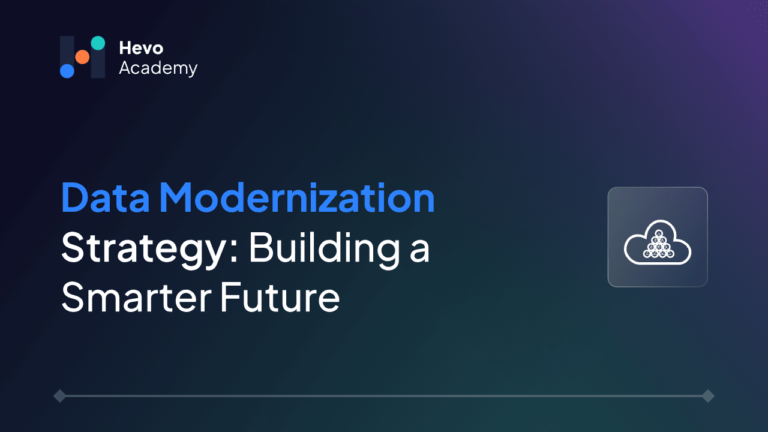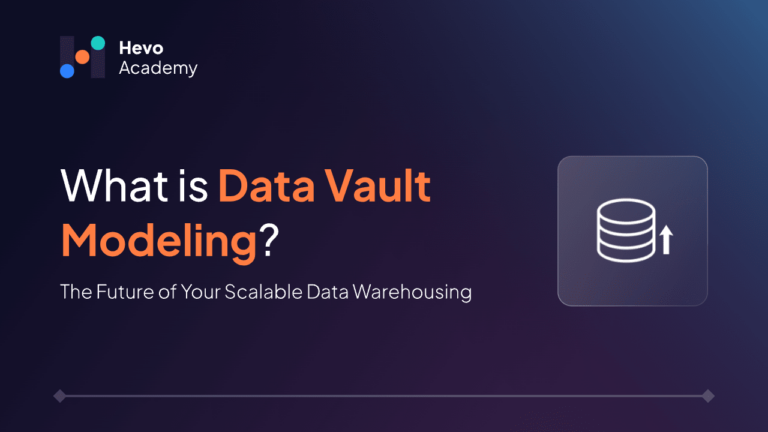It is estimated that 2.5 quintillion bytes of data are produced every day, hence the need for firms to tap into this information. In today’s data-driven landscape, data dwells everywhere, and data modernization is a crucial step for businesses to stay competitive. Data modernization enables the transformation of outdated IT systems and supports adopting new technologies such as cloud, AI, and analytics, in addition to enhancing data access, flexibility, and protection.
Table of Contents
Businesses need to advance their data modernization strategy to achieve the best results, support more intelligent decisions, and prepare for the future. Through data modernization, companies can accelerate growth, secure their goals, and build a better future by rethinking data architectures and strengthening digital strategies. This article explores the essence of data modernization, practical strategies for a data-first approach, and the importance of a modern data stack.
What is data modernization?
Data modernization refers to updating and transforming data systems, infrastructure and practices from traditional forms to cloud based formats that are more effective in terms of delivering analytics.
Data modernization is a strategic methodology and often refers to the process of lifting of data from old databases to new databases. The future of data platforms is to transform the large sets of data, some of which can be useless when isolated, into data that changes the world. This involves transitioning from outdated infrastructures to modern solutions that leverage advanced technologies like cloud computing, AI, and real-time analytics.
Organizations improve data security and efficiency by modernizing data processes and, therefore, support the improvement of data quality.
Benefits of Data modernization
Data modernization contains a key of revolutionizing benefits that shift improve organizational performance making the organization ready for the dynamic digital world.
1. Improved Decision-Making
Advanced data facilities provided organizations with more current, accurate and updated database information.
- Using the results, leaders can only respond quickly to shifting market trends and make decisions.
- Acquiring a single data system frees up valuable time and erases any questions so that strategies are data-based.
2. Increased operation efficiency
Data modernization improves the status, techniques, and formats of data, making it easier by automating repetitive tasks.
- Many activities that previously required a lot of data input or output are made faster because of simplified processes.
- Better information integration increases communication within organizations.
3. Scalability and Flexibility
Integrated modern business systems are capable of flexibility, which can change according to the needs of business.
- The resources needed in the businesses can be easily increased or decreased in accordance with the overall need.
- New data sources or technologies can be integrated without disrupting operations.
4. Regulatory Compliance
The modern systems help the companies to guarantee that data handling is in accordance with the most current regulation and standards.
- Better governance tools assist in tracking and auditing of data usage and this has been made easier..
- Accordingly, the occurrence of compliance risks and related penalties decreases due to encryption and access control.
5. Competitive Advantage
Therefore, companies get a significant competitive advantage when they implement contemporary data strategies
- Gathering data at a faster pace aids the companies to provide an enhanced product and service.
- This is possible because businesses with early identification of the trends can innovate beyond the competition.
Components of Data Modernization
1. Data Integration
Data integration is the process that brings data from various sources into a single point of view.
- Importance: It provides assurance that all business units get the right and synchronized data.
- Benefits: Efficiency by arrangement of work flow, elimination of several cycles and enhanced co-ordination between the teams.
- Tools: ETL, (Extract, Transform, Load) platforms.
2. Data Quality
Data quality management is the process by which data arrives at the state of being accurate, complete, consistent, and reliable.
- Importance: Data inconsistency can result in wrong decision-making and even can cause some financial losses.
- Benefits: Data quality improves the way business functions, customer confidence, and adherence to legal requirements.
3. Data Warehousing
Data warehouse is a central and secure place that stores current structured and historical data where complex queries, reporting, and analysis jobs are performed.
- Importance: Improves decision-making processes since it offers a strong foundation for data consolidation.
- Benefits: The benefits would be; Scalability, cuts in storage space, and better reporting.
- Tools: These are Snowflake and Amazon Redshift that have been proposed under cloud solutions.
4. Cloud Computing
This is a large and efficient way of providing the storage of data or handling millions of transactions.
- Importance: Removes physical structures and provides flexibility and accessibility worldwide.
- Benefits: Precision, speed, and availability worldwide.
5. Business Intelligence (BI)
A fundamentally systematic method of Information System capturing data and converting them into useful commercial information.
- Importance: Helps in translating and quantifying goals, and significant performance indicators of interest to an organization.
- Benefits: Enhance overall corporate planning and strategizing, reduce planning time and cycles, and improve organizational functionality.
- Tools: Tableau, Power BI, Looker.
Explore more about business intelligence vs data analytics and learn how each plays a crucial role in extracting insights from data.
6. Data Visualization
The way of how large amounts of data is provided in the forms of graphical charts, intra-dashboards, and heat maps.
- Importance: It helps identify trends and anomalies that augment analytical narrative and data presentation and communication.
- Benefits: Improves decision-making process and coordination between teams.
7. Data Governance
Observes how data is processed in a way which is legal and reasonable according to the norms and regulations. Read about implementing data governance strategy ensure that data is appropriately used
- Importance: They confirm responsibility, discretion and compliance with rules and regulations.
- Benefits: Better trust, improvement in the standardization, and bettering of data quality.
How to create a Data Modernization Strategy
A data modernization strategy outlines how an organization will improve its data management practices. It involves a series of steps to upgrade data, tools, and infrastructure.
Step 1. Assess Current Data Infrastructure
First, define what is a data system at the moment, where inefficiencies and problems exist. When learning in this assessment it indicates the area that requires improvement as well as the major areas of concern.
Step 2. Define Clear Objectives
Define realistic objectives for your modernization plan, whether to boost decision-making, achieve better scalability, or maintain compliance. They are your roadmap and a way of putting together measures to determine whether progress is being made.
Step 3. Selecting Elements Of The New Modern Data Stack
Technologies emerging into the market include cloud computing, Artificial Intelligence, and big data platforms; the best thing is that you have to select them depending on your business needs. The right tools make your infrastructure fit the current environment as well any future ones that may occur.
Step 4. Develop a Roadmap
Develop a roadmap of small and large goals that dictates the process of data modernization in your organization. When there is a strategic map, it is easier to order goals and priorities and therefore allocate resources appropriately.
Step 5. Migrate to the Cloud
Migrate your data and applications to the cloud to realize the benefits of flexibleness, scalability, and affordability. One of them is to be organized in such a way that the migration process is as secure as possible, interfering with the functionality of the organization as little as possible.
Step 6. Optimize Data Governance
Establish strong and scalable data governance policies that will ensure data accuracy, compliance and, therefore, trust. Security and ethical consideration requires such a step.
Step 7. Implement Automation and AI
Automate the done process to minimize the manual work involved and incorporate AI to upgrade the analytic instruments. Process control and innovation and use of Artificial Intelligence enhances productivity and makes predictions.
Step 8. Train Your Teams
Offer awareness to enable your staff to meet the expected standard in handling the current systems. This means that these changes are well adopted and the organizational benefits of modernization well harnessed. Organize leadership training, workshops, and certification that focus on technical skills in technologies like cloud, AI, and analytics tools. In addition, creating organizational culture where people are encouraged to learn promotes employees’ acceptance of change and improvement processes.
Step 9. Monitor and Adapt
Periodically analyze system effectiveness and implement changes as often as the changing needs of a business and other advancements dictate. Use key performance indicators (KPIs) and advanced analytics to assess system performance and track progress toward business goals. Regular reviews allow organizations to adapt to changing needs, emerging technologies, and market dynamics.
Examples of Data Modernization
1. Retail Industry
A large retailer changed a data infrastructure to use cloud and allowed tracking of inventory in real time as well as search into the future. This modernization made smooth supply chain flow, minimized stock out situations and created a high level of satisfaction from the customers.
2. Healthcare
One of the major healthcare organizations established the use of artificial intelligence and machine learning into its data platform to improve diagnosis and treatment regimens. Using data analysis outcomes and of patients were enhanced in addition to managing hospital resources efficiently.
3. Financial Services
A major global bank decided to transform its data infrastructure to operational analytics for more effective fraud prevention and controls. Using the ML techniques enabled the bank to recognize outlier transactions as they occurred, thus cutting down on its losses and increasing security.
4. Manufacturing
A manufacturing company highlighted that it was able to upgrade its data department with IoT, and cloud technologies. This made it possible to continuously track the performance of the equipment, schedule maintenance to prevent unnecessary time on the bench, and apply data analysis applied to improving production procedures.
Key Takeaways
Data modernization holds the potential to open up new possibilities, create things that did not exist before, and increase the pace of growth for anyone interested in improving their business. New data understanding is crucial for anyone who would like to stay relevant and competitive in the contemporary business world. When you upgrade the data processing system in your business, you enhance the quality and range of information, as well as security, thereby enhancing operation effectiveness.
Consequently, therefore, data modernization initiatives should both have an actionable plan and the proper toolbox as well as develop skills where needed. Cloud adoption as well as the integration of superior analytics and AI remains fundamental when it comes to data modernization. . Schedule a personalized demo with Hevo for seamless data integration.
FAQs
1. What are the three strategic pillars of a modern data strategy?
The three strategic pillars of a modern data strategy are:
Data Architecture – Leveraging flexible, scalable, and cloud-based infrastructure.
Data Governance & Security – Ensuring data privacy, integrity, and compliance.
Data Analytics & Insights – Using advanced tools and AI to derive actionable business insights.
2. What is a modernization strategy?
A modernization strategy involves upgrading legacy systems and processes with current technologies and methodologies to improve efficiency, security, and scalability, ultimately driving business growth and competitiveness.
3. What is the data modernization initiative?
The data modernization initiative is a comprehensive approach to transforming legacy data systems into modern, cloud-based platforms that support faster decision-making, scalability, and advanced analytics, allowing businesses to maximize the value of their data.





